Term archive
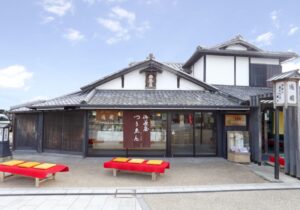
投稿タイプ:sightseeing
Tsuen-chaya Teahouse
Uji-bashi Bridge has been a vital point in Uji throughout its long history. This long-established teahouse, located on the east bank of the river, was built in 1160. It has served as not only a teahouse, but also a guardian of the bridge, wishing for the safety of travelers passing by. It is the oldest existing teahouse in Japan.
The current building was constructed in 1672, showcasing the architectural style of machiya (traditional townhouses) in the Edo Period (around 1603-1868). It is registered as a part of the Japan Heritage (Japanese Tea: Eight Centuries of Tradition).
Inside the teahouse, you can find chatsubo (traditional tea jars) made centuries ago, the wooden statue of the first-generation Tsuen created and presented by Ikkyu Sojun enshrined within, and a wooden bucket that is said to have been made by Sen no Rikyu and used by Toyotomi Hideyoshi to draw the clear water of the Uji River. Renowned historical figures, including Ashikaga Yoshimasa, Toyotomi Hideyoshi, and Tokugawa Ieyasu, have visited this teahouse.
At the storefront, you can purchase matcha (powdered green tea), sencha (one of the most common Japanese teas), hojicha (roasted tea), and more. Inside, you can enjoy matcha sweets like parfaits and zenzai (dessert soup made with red beans) made with plenty of freshly ground matcha, a combo of matcha and cha-dango (skewered rice dumplings made with matcha), cha-soba (buckwheat noodles made with matcha) and so on, while gazing out at the Uji-bashi Bridge and Uji River.
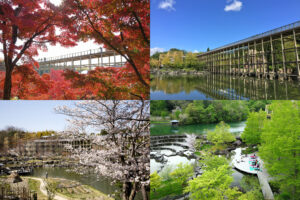
投稿タイプ:sightseeing
Keihanna Commemorative Park
The Keihanna Commemorative Park, officially called the Kyoto Prefectural Kansai Culture and Science City Commemorative Park, is 24.1 hectares in size. It was built to commemorate the establishment of the Keihanna Science City (officially known as the Kansai Science City), and opened to the public in 1995. It has a free area and a paid area. The free area includes Hiroba (Open Space), which has a large, stepped lawn area resembling a tanada (rice terrace), where people can relax and children can run and play freely. There is also a free playground for kids. In the Taniai (Valley) area, you can view a typical Japanese landscape with a small stream, a bamboo grove, and a plum garden. In the paid area, there is Suikei-en, a Japanese-style garden with paths that bring you to fascinating spots including a cascading pond, a magnificent Rock Cluster, beautiful places with seasonal flowers, and Floating Stage where you can feed Japanese carp. It’s enjoyable for children and adults alike. Kangetsukyo Bridge is eye-catching. It’s 123 meters long, 4 meters wide, and approximately 10 meters tall above the water. From the bridge, you can enjoy the panoramic view of the large garden. Particularly spectacular is the fall foliage of the Maple Valley. Among the moss, approximately 140 Japanese maple trees line a small, delicate stream. Suikei-en is a wonderful place where you can view both satoyama (cultivated countryside) landscapes, and the large and beautiful bridge. Also, at Mebuki-no-Mori (Budding Tree Forest), you can enjoy strolling through abundant nature, which offers different scenery depending on the season. Additionally, you can enjoy a range of events, from firefly-viewing and star-gazing to traditional Japanese events.
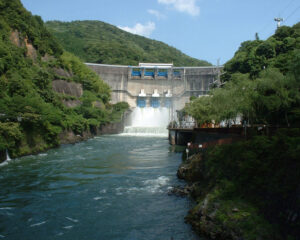
投稿タイプ:sightseeing
Amagase Dam
This multipurpose dam was constructed in 1964 to prevent floods, generate electricity, and supply drinking water. The majestic Amagaze Dam, standing at a height of 73 meters and a length of 254 meters, is a dome-shaped arch dam. If you're lucky, you might see the spectacular sight of the dam releasing water.
One of the dam’s charms is its location. It’s close to the city center of Uji, making it a relatively convenient stop for those sightseeing or going on a cycling trip. Downstream from the dam, there are World Heritage sites, Byodoin Temple and Ujikami Shrine.
From the dam, you can see the reservoir called Lake Houou (Lake Phoenix). Its shape resembles a bird spreading its wings, and the name represents people's hope to create a paradise on earth. You can enjoy the amazing view of the lake with the seasonal beauty of nature around it.
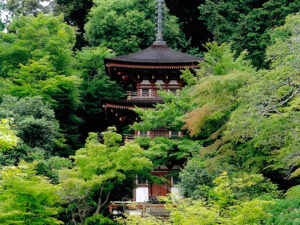
投稿タイプ:sightseeing
Joruriji Temple
Joruriji Temple, located in the southern part of the Kyoto Tea Country region, is a temple of the Shingon Risshu sect of Buddhism. Though the early history of the temple is shrouded in mystery, historical records of the temple state that the monk Gimei enshrined Yakushi Nyorai (the Medicine Buddha) in the first main hall in 1047. Yakushi Nyorai is the master of Eastern Pure Land Buddhism, and is officially called “Yakushi Ruriko Nyorai,” which is the origin of the temple's name.
The temple houses National Treasures (the Main Hall, the Three-Storied Pagoda, nine statues of Amida Nyorai, and statues of the Four Heavenly Kings) and several Important Cultural Properties, including the statue of Yakushi Nyorai.
In the main hall, the nine Amida Nyorai statues are lined up in a long row, which is quite splendid. It is said that approximately 30 halls like this were built around Kyoto in the Heian Period (794-1185), but this is the only one that still exists in a perfect form.
The temple’s garden depicts Gokuraku Jodo (the Pure Land in Buddhism). To the east of the main hall is a garden with a serene pond, and beyond the pond, there stands the Three-Storied Pagoda with the Yakushi Nyorai statue enshrined in it. The pond is said to be in the shape of the Sanskrit letter (the Siddham script) "a." The garden has remained in its original state, making it a rare and precious place. Surrounded by abundant nature, it is designated as the Place of Scenic Beauty in Japan.
You can enjoy beautiful scenery throughout the year. Moreover, paths connecting Joruriji Temple and Gansenji Temple called Sekibutsu no Michi (paths with stone Buddhas) are a great place for hiking through history where you can meet many stone Buddhas.
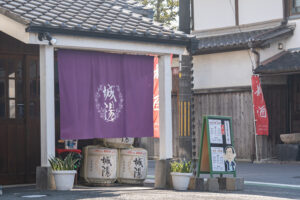
投稿タイプ:sightseeing
Joyo-Shuzo
Joyo-Shuzo, located in Joyo City, is the southernmost sake brewery in Kyoto, and the only sake brewery in the Kyoto Tea Country area. It was founded in 1895. The brewery takes advantage of the region’s nature and land features, including using the pure groundwater, to create its sake.
In the International Wine Challenge 2024 (SAKE division), its Junmai-Daiginjo 40 (Yamadanishiki) “Joyo” was a gold winner, and Junmai Ginjo 55 (Yamadanishiki) “Joyo” was a silver winner.
In addition to sake, the brewery is also known for its umeshu (Japanese plum wine) made with one of Joyo’s specialties, a premium plum variety called Joshuhaku. Their umeshu are aged for over three years, and made without any additives.
Besides, the brewery buildings, which have been there since the founding of Joyo-Shuzo, exude a historical charm.
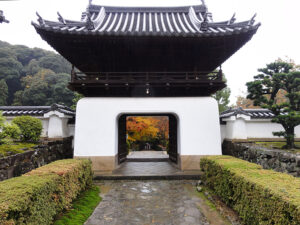
投稿タイプ:sightseeing
Koshoji
This Soto Zen temple was a training monastery opened in Fukakusa (Fushimi) by the Buddhist monk Dogen Zenji in 1233. It was rebuilt in Uji in 1645 by Nagai Naomasa, the lord of Yodo Castle at that time. Interestingly, the temple was built using the remains of Fushimi Castle.
In addition to the seven-hall complex, the Kotosaka slope is wonderful as well. It’s the quaint approach from the stone gate to the Sanmon gate, where many visitors enjoy the tunnel of fall foliage or summer greenery. Other highlights include the Sanmon gate built in Ryugu-zukuri (architectural style reminiscent of Dragon Palace Castle that appears in Japanese folklore); the corridor of Uguisu-bari (squeaking hallway floor making a sound like the chirp of a nightingale, which is said to have been made to alert those within earshot to the danger of an intruder) and the Chitenjo (bloody ceiling); the Tenarai Kannon bodhisattva that is believed to have been enshrined at a historical site of the classic literature, The Tale of Genji.
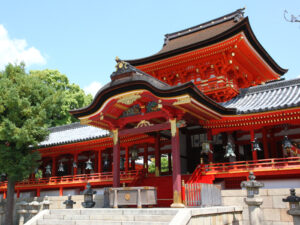
投稿タイプ:sightseeing
Iwashimizu Hachimangu
Iwashimizu Hachimangu is one of the three major Hachimangu shrines. This majestic shrine, with a nearly 1,200-year history, is considered Japan's second most important shrine after Ise Jingu (Ise Shrine). The shrine is dedicated to Hachiman Okami, believed to be ancestors of the emperors of Japan. Since ancient times, Hachiman Okami have been deeply revered as guardian deities of Kyoto and the nation in this shrine. This profound reverence has been passed down through generations of emperors as well.
It was also a sacred place of worship for some of the most famous samurai warriors in history. The Minamoto clan (Genji), who established the Kamakura shogunate (1185-1333), highly respected Hachiman Okami as their tutelary deities. Even after the fall of the Minamoto clan, Iwashimizu Hachimangu has remained one of Japan's most important shrines to this day.
Moreover, it has National Treasures including the main building of the complex, which is adorned with intricate, colorful carvings. In its long history, the building complex was renovated by Oda Nobunaga, and the cloisters were built by Toyotomi Hideyoshi and Hideyori. The current complex was rebuilt by Tokugawa Iemitsu and completed in 1634. It is the oldest and one of the largest surviving Hachiman-zukuri (a traditional Japanese architectural style seen at Hachimangu shrines) in Japan.
The shrine holds a special place in Japanese history, and is also a visually stunning place. It offers amazing views of cherry blossoms in spring, and a beautiful contrast of fall foliage and evergreen trees in fall.
At the entrance of the shrine at the foot of the mountain, there is a 9-meter-tall stone gate called Ichi-no-Torii. On the upper part of it, you'll find a tablet with kanji (a Chinese character) of “hachi (八)”, in “Hachimangu (八幡宮)”, written in the shape of two pigeons. Actually, pigeons are considered as messengers of the deities, Hachiman Okami. Pigeons can be found hidden as motifs throughout the shrine. You can even find adorable pigeon-shaped omikuji (small items containing fortune-telling slips) and omamori (Japanese amulets).
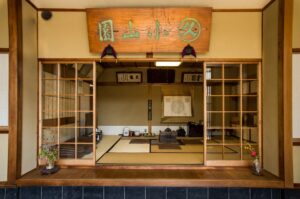
投稿タイプ:sightseeing
Marukyu Koyamaen (Head Office Plant / Head Office)
Kyujiro Koyama began cultivating tea here in the Genroku era (1688-1704). After four generations, they began selling tea, and by the eighth generation, they expanded their market nationwide. Later, their tea became beloved worldwide. Even now, 300 years after its establishment, they continue to produce tea with a focus on flavor and safety, with their corporate motto "Making Teas with Quality as the Highest Priority." Everything from cultivation to production is done in-house, and in order to continually improve the quality of their teas, they're also very involved in entering tea competitions. As a result, they have repeatedly received the Ministry of Agriculture, Forestry and Fisheries Award. This is a testament to their outstanding work.
Marukyu Koyamaen's wide lineup includes matcha (powdered green tea), sencha (one of the most commonly drunk Japanese teas), and gyokuro (premium green tea), as well as matcha-flavored sweets, beverages, and more.
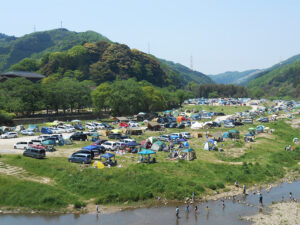
投稿タイプ:sightseeing
Kasagi Campground
Kasagi Campground is a popular camping spot along the Kizu River in southern Kyoto. Spanning approximately 30,000 square meters, it offers a spacious and relaxing environment. It's conveniently located, making it easily accessible from Kyoto, Osaka, Nara and so on. You can drive your car directly into the campground. The prices are affordable, and reservations are not required. It's an excellent spot for casual camping, getting away from the city.
The campground provides basic amenities such as kitchen sinks, Western-style toilets (please bring your own toilet paper), and a garbage disposal area. To take a shower, you can visit Kasagi Barbecue Company M5 (300 yen per 5 min.) near the campground entrance.
Enjoy Barbecue, camping, fishing and more, while viewing the beautiful river scenery. The clear night sky is perfect for stargazing, too. In the spring, cherry blossoms are also wonderful. You can spend a relaxing time under the cherry trees.
Beyond camping, the surrounding area offers opportunities for rock climbing, hiking and exploring Mount Kasagi. On the mountaintop, there is Kasagidera Temple that is famous especially for its enormous Magaibutsu (Buddhist figures carved into boulders). The temple is impressive, and the momiji (Japanese maple leaves) are beautiful especially in the fall. Right by the temple, there is Matsumototei where you can savor pheasant dishes (reservation required), too. Moreover, you might see a sea of clouds from the mountain in the cold season, if you’re lucky.
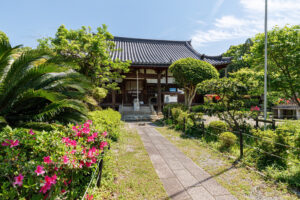
投稿タイプ:sightseeing
Eshin-in Temple
It is said that the origins of Eshin-in Temple can be traced back to Ryuzen-ji Temple, an ancient temple founded by Kobo Daishi (Kukai).
In 1005, it was rebuilt by a Buddhist monk called Genshin (Eshin Sozu). He is renowned as the compiler of Ojoyoshu (The Essentials of Rebirth in the Pure Land). Also, he is said to have been the model for the monk in The Tale of Genji, which is a very famous, long novel written in the Heian period (794-1185).
This temple is known as “The Flower Temple,” too. Depending on the season, you can enjoy a variety of flowers that soothe the heart and bring about a peaceful mind. Immerse yourself in the beauty and the temple’s rich history.
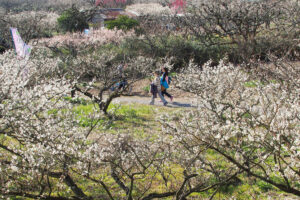
投稿タイプ:sightseeing
Aodani-Bairin Plum Grove
This ume (Japanese plum) grove, sprawling across the gentle hill along the Aodani River, has been a renowned plum blossom viewing spot since olden times. It’s even seen in poetry written by Emperor Godaigo’s son in the 14th century, which tells us that the grove has a very long history.
Covering approximately 20 hectares with many plum trees, it boasts the highest plum fruit production in Kyoto Prefecture.
The plum varieties grown in this grove include Joshuhaku, whose fruit is known as the local specialty of Joyo City. People enjoy the large, thick-fleshed and fragrant fruit as umeboshi (pickled ume fruit that is very sour and salty, often enjoyed with rice), jams, sweets, alcoholic beverages, and more.
This area is rich in nature and has a warm, cozy atmosphere. Near the grove, there is Naka Tenman Shrine, too. You can enjoy leisurely strolls around here.
Every year around late February to mid-March, there is the Plum Blossom Festival around the ume grove, celebrating the blooming of the flowers and the arrival of spring. In this season, you can find pretty white and pink blossoms with a delicate sweet fragrance in the city.
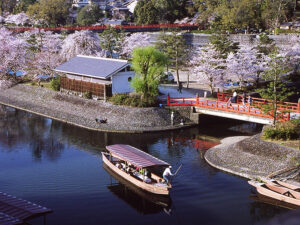
投稿タイプ:sightseeing
Tonoshima Island & Tachibanajima Island on Uji River
On Uji River, there are Tonoshima Island and Tachibanajima Island. They are collectively called Nakanoshima Island. Nakanoshima Island and Yorimichi Park on the left bank are collectively called Uji Park. Four bridges (Asagiri Bridge, Kisen Bridge, Tachibana Bridge and Nakajima Bridge) connect the two islands and both riverbanks.
This area is renowned as a great hanami (cherry-blossom viewing) spot, and in early April, Ujigawa Sakura Festival is held on and around the islands.
In the summer, “Cormorant Fishing on the Uji River” is held. (Cormorants are birds. Cormorant masters wearing traditional clothing manipulate them to catch fish.) This is why you can see a cormorant shed on Tonoshima Island.
In early October, Uji Tea Festival is held in this area, too.
On Tonoshima Island, there stands a beautiful 13-story pagoda that is around 15 meters tall. It was built by Eison in 1286, praying for the souls of fish. Eison was a Buddhist monk of Saidaiji Temple in Nara. In 1756, a great flood caused the pagoda to collapse and become buried. Around the end of the Meiji Period (1868-1912), A large part of it was excavated, and the entire pagoda was rebuilt.
